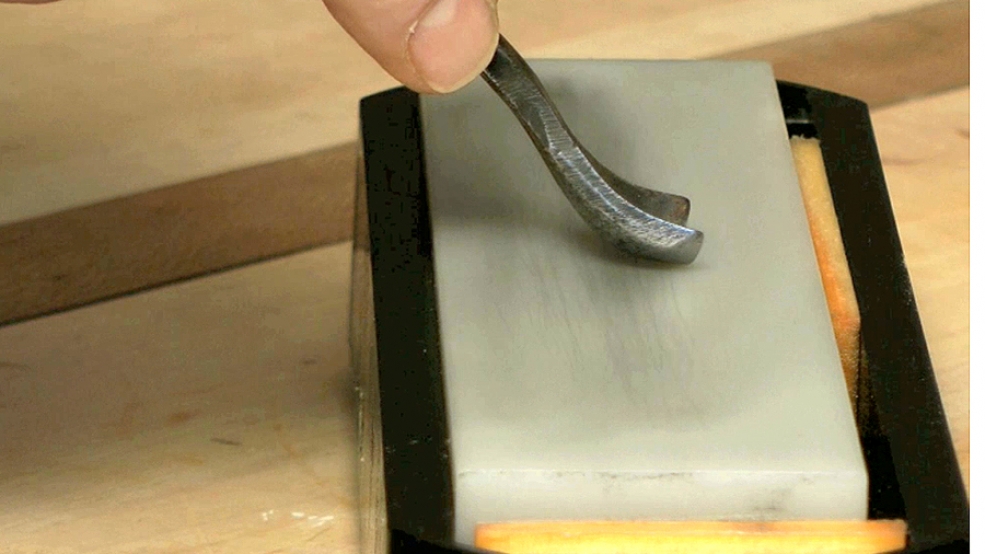You've just watched Sharpening Shortbent Gouges
More videos from


There are 2 fundamentally different types of shortbent (spoon) gouges and they need to be sharpened somewhat differently...

| 21 January 2024 09:36
Darrin - That you are looking at the bevel and can see multiple facets is a good thing!
When sharpening ANY carving tool, the two guides to judge and monitor your progress are:
1. The white line of light that is your eventual cutting edge - keeping it uniform as it attenuates to nothing)
2. The scratch pattern on the bevel from the stones you are using - telling you how you are presenting the metal to the stone.
So, looking at the 'multiple bevels' is a good thing in that you ARE looking. That they are present tells me that you are offering the bevel to the stone at a different angle each time.
This usually happens when someone takes the blade from the stone to have a look at the scratch marks and then not replacing it exactly where they had it before.
Thing is, if you have narrow L & R shortbent skew, you don't have a lot of metal to play with so you need to be quite sedulous when it comes to going back to the stone. Perhaps a little jig might help.
Also you probably don't need to look at the bevel so often?
And, lastly, don't worry if you round over the back corner of the skew (ie not the pointy corner); you won't use it. But do make sure the whole edge is sharp.
Hope this helps.
Slow down, take it easy, and take longer to set the bevel at a consistent angle before starting to sharpen.

| 20 January 2024 06:40
Hi Chris. Happy New Year! I've been able to sharpen my short bent gouges and grounders with good results. When it comes to my short bent skew chisels (Henry Taylor), the results are awful. I've been trying my best to maintain a 20 degree angle, keeping the cutting edge perpendicular to the edge of the sharpening stone, so that the handle is the same angle as the skew, but I'm ending up with multiple bevels (or maybe facets is the better word). Any ideas on what's going wrong?
Thanks, Darrin.

| 23 January 2016 14:40
Tobias - Longbent gouges. Thanks for the suggestion, will do asap.

| 22 January 2016 18:27
William -The problem is that there isn't such a thing as a standard crank for a shortbent. 20 degrees is about what the 'wedge' should be but it's difficult to judge, really, it's a matter of the tool feeling right, feeling as if it cuts as if it were straight.

| 22 January 2016 16:08
I agree with Tobias; a long bent video would complete this appealing series.

| 22 January 2016 14:07
Any advice for long bent gouges please?

| 19 January 2016 16:09
With the grounding short bent, how do you judge the cutting angle of 20 degrees? I have resorted to gauging this by the length of the bevel, which is considerably longer than a stock Pfeil, for example.

| 19 January 2016 01:29
William - Have a look at the Sharpening section in the directory on the left and you'll see a video on chisel (and skew) sharpening. There is really no difference between widths except there's more metal to deal with and thus it takes longer with the wider ones.

| 18 January 2016 15:55
Still hoping for a video on chisel sharpening, especially for those 30mm and more.

| 16 March 2014 14:35
Chris - You can clean up the inside of a shortbent gouge with fine emery paper, or a fine slipstone coming in at a bit of an angle. You don't need to add an inside bevel as such but, yes, you do want to clean up any rust; you cannot have pitting encroaching on the cutting edge.

| 12 March 2014 21:11
Would you ever recommend doing anything to the inside of the shortbent gouge to touch it up? Say, for example that it was an older tool with a bit of rust? If so, how would you do this?

| 02 October 2012 03:05
William - That's a good suggestion and one we must address in the future. In the meantime, sharpen with a single bevel of 15-20 degrees on each side. You can sharpen them on benchstones - make sure they are flat - just like bench chisels.

| 01 October 2012 18:07
I'd like to see a video explaining how to deal with new chisels. Do you change the bevel angle on a brand new Feil chisel? If so, how to do it, especially on widths greater than 24 mm?

| 21 July 2012 11:48
Very informative. Technique is definetly key to sharpening. It's good to be reminded of this and see it practiced.